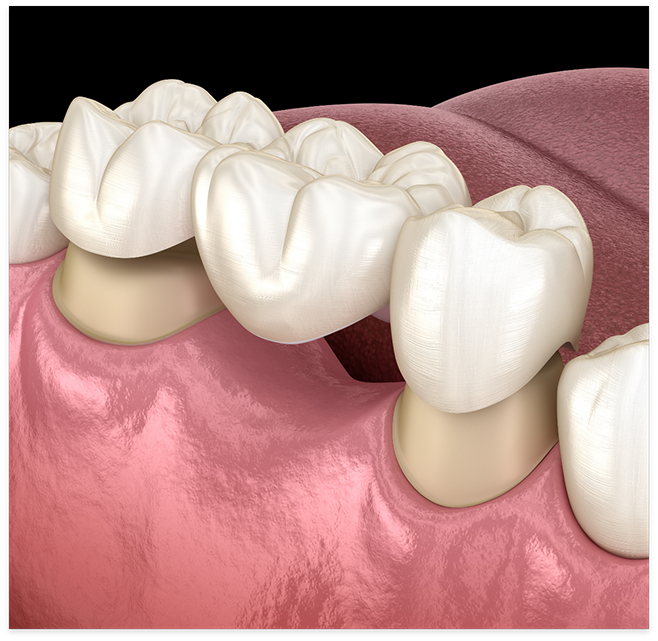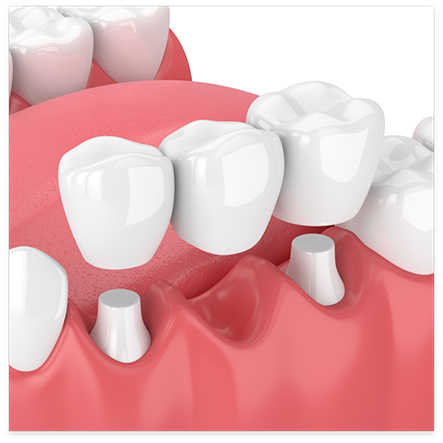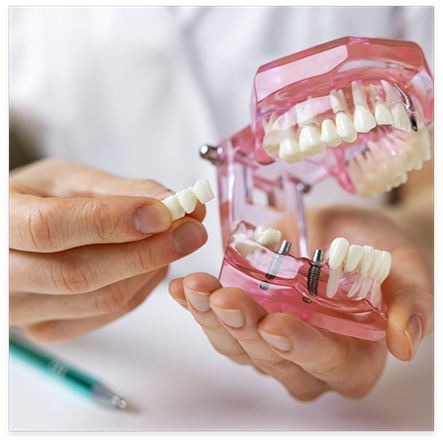Dental Bridges Cottonwood Heights
Bridge the Gap Between Teeth Today
For many people, just losing one tooth is bad enough. The resulting gap can look unsightly and cause oral health issues. Needless to say, then, it’s easy to feel stumped when you’re missing several adjacent teeth. Fortunately, there is a solution for that particular problem: dental bridges in Cottonwood Heights! Dr. Hansen at White Peak Dental provides these appliances to restore smiles beautifully. To learn more about how they could help you, just keep reading or call our office to book a visit.
Why Choose White Peak Dental for Dental Bridges?
- Honest, Pressure-Free Dentistry
- Professional & Knowledgeable Dental Team
- We Accept & Maximize Dental Insurance
What is a Dental Bridge?

Put simply, a dental bridge is a fixed dental restoration made to replace several adjacent teeth. It consists of two dental crowns fused to either side of anywhere between one and four replacement teeth.
Generally, the best dental bridge candidates have:
- One or more missing permanent teeth in an arch
- Healthy natural teeth and bone structure that support the bridge
- Good oral hygiene practices that help maintain bridge stability
The Types of Dental Bridges

You'll have a consultation with Dr. Hansen as the first step of a dental bridge procedure. This visit allows him to perform an oral exam, learn your smile goals, and review your health history. He can confirm whether a dental bridge would work for you based on how these tasks go.
If our team proceeds with treatment, the consultation findings will determine which type of bridge suits you best. In particular, our office will recommend one of the following:
Traditional Dental Bridge

The traditional dental bridge is the more well-known type. It’s usually formed by an artificial tooth (i.e., pontic) secured by dental crowns, with the latter prosthetics cemented to abutment teeth.
Due to relying on natural teeth, this bridge is best for patients with a small smile gap. Keep in mind, though, that placing it will remove some of your enamel.
Implant Bridge

Rather than dental crowns, an implant bridge uses dental implants – prosthetic teeth that fuse with your jawbone. As such, it’s permanently affixed to your mouth and won’t slip or fall.
Compared to traditional bridges, implant ones have unique benefits. For one thing, placing them doesn’t require a dentist to shave off any of your enamel.
The Benefits of Getting a Dental Bridge

A dental bridge remedies the problems associated with tooth loss. More specifically, it offers advantages like:
- A Beautiful, Restored Smile: Due to using high-grade materials, a dental bridge’s teeth look natural and lifelike.
- Better Body Image: Going without teeth can make you feel insecure. In contrast, a dental bridge restores not only your smile but also your confidence.
- Easier Eating & Speaking: Bridges act like natural teeth, which generally help you eat and speak. Implant types even have the advantage of being fused in place.
Ultimately, you can trust a dental bridge to heal your broken smile. Therefore, go ahead and book a visit to our office soon!
Dental Bridges FAQs
After everything you’ve read, maybe you want dental bridges in Cottonwood Heights. That’d certainly make sense – the prosthetics do a great job filling smile gaps! Still, perhaps you have a few concerns about them. Below, our staff has listed the answers to some oft-asked dental bridge questions. Read them over to better understand our restorations. Otherwise, just call us for any other details.
Is Getting a Dental Bridge Painful?
Thankfully, you won’t need to expect pain from dental bridge treatment. The placement process is entirely ache-free.
You see, dentists take precautions when placing bridges. They’ll numb the relevant teeth before the prep work begins. With just a bit of topical anesthetic, then, the most you’ll feel from a bridge procedure is some slight pressure.
Of course, the treated teeth may feel a tad sore after treatment. This effect, though, is entirely normal and fades after a few days. Plus, the pain is manageable with over-the-counter medications. (Do contact your dentist, however, if the discomfort worsens.)
How Many Teeth Can a Dental Bridge Replace?
Technically, a dental bridge can replace one to four missing adjacent teeth. That said, dentists usually have it replace one or two.
The reason for this setup has to do with appliance stability. The longer a bridge extends, the less stable it becomes – especially when the abutment teeth aren’t healthy. Therefore, having the restoration replace three or more teeth is pretty risky.
On the other hand, it’s possible to reduce the risk. If you opt for implant bridges instead of regular ones, the implants will ensure your new teeth stay strong and secure.
Are Dental Bridges Safe?
When placed by a qualified dentist, a dental bridge won’t cause you any harm. Whether at the placement stage or afterward, your new teeth will only help your health in the future.
The biggest reason for this fact is that all bridges are non-toxic. Metal ones don’t have mercury, while ceramic and zirconia kinds are also toxin-free. As such, you don’t have to worry about adverse bodily effects.
Granted, there is a small risk of allergic reactions to a bridge’s metal alloy. However, such reactions are minor and not worth much concern. After all, you can always opt for a metal-free bridge instead.
Do Dental Bridges Feel Natural?
Contrary to rumor, you can expect your permanent dental bridge to feel natural. You might even forget that you’ve lost teeth if given enough time.
For starters, bridges are made from durable materials. This allows them to withstand everyday chewing forces just as easily as tooth enamel. Consequently, eating with them won’t feel strange.
Remember that each bridge is made to fit comfortably. Your dentist will have reshaped your teeth to that end, as well as taken custom dental impressions. Given these facts, the final restoration shouldn’t feel awkward or noticeable.
